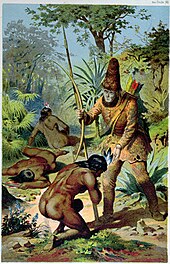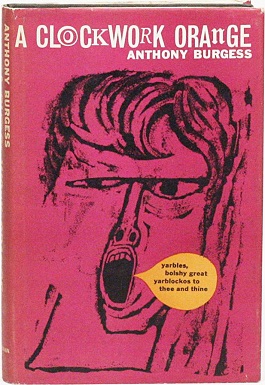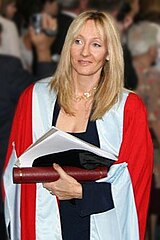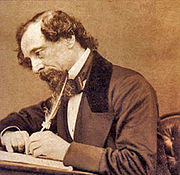From Wikipedia, the free encyclopedia
British literature refers to literature associated with the United Kingdom, the Isle of Man and the Channel Islands as well as to literature from England, Wales and Scotland prior to the formation of the United Kingdom.
By far the largest part of British literature is written in the English language, but there are bodies of written works in Latin, Welsh, Scottish Gaelic, Scots, Cornish, Manx, Jèrriais, Guernésiais and other languages. Northern Ireland has a literary tradition in English, Ulster Scots and Irish. Irish writers have also played an important part in the development of English-language literature.
Literature in the Celtic languages of the islands is the oldest surviving vernacular literature in Europe. The Welsh literary tradition stretches from the 6th century to the 21st century. The oldest Welsh literature does not belong to the territory we know as Wales today, but rather to northern England and southern Scotland. But though it is dated to be from the 6th, 7th, and 8th centuries, it has survived only in 13th- and 14th century manuscript copies.
[edit] Latin literature
Chroniclers such as Bede, with his Historia ecclesiastica gentis Anglorum, and Gildas were figures in the development of indigenous Latin literature, mostly ecclesiastical, in the centuries following the withdrawal of the Roman Empire.
[edit] Old English literature
Old English period :450-1066 The earliest form of English literature developed after the settlement of the Saxons and other Germanic tribes in England after the withdrawal of the Romans and is known as Old English or Anglo-Saxon. Epic poem Beowulf is the most famous work in Old English. A hero of the Geats, Beowulf battles three antagonists: Grendel, Grendel's mother; and a Dragon. The only surviving manuscript is the Cotton manuscript. The precise date of the manuscript is debated, but most estimates place it close to the year 1000.(The oldest surviving text in English is Cædmon's Hymn)
A popular poem of the time was "The Dream of the Rood." It was inscribed upon the Ruthwell Cross.
Another poem was "Judith (poem)." It was a retelling of the story found in the Latin Bible's Book of Judith of the beheader of the Assyrian general Holofernes.
Chronicles contained a range of historical and literary accounts; one example is the Anglo-Saxon Chronicle.
[edit] Late medieval literature in England
Latin literature circulated among the educated classes.
Following the Norman Conquest, the development of Anglo-Norman literature in the Anglo-Norman realm introduced literary trends from Continental Europe such as the chanson de geste.

In the later medieval period a new form of English now known as Middle English evolved. This is the earliest form which is comprehensible to modern readers and listeners, albeit not easily.
The most significant Middle English author was the poet Geoffrey Chaucer who was active in the late 14th century. His main works were The Canterbury Tales and Troilus and Criseyde.
The multilingual audience for literature in the 14th century can be illustrated by the example of John Gower, who wrote in Latin, Middle English and Anglo-Norman.
Religious literature, such as hagiographies enjoyed popularity.
Women writers such as Marie de France and Julian of Norwich were also active.
- Sir Gawain and the Green Knight (Most likely the Pearl Poet)
- Le Morte d'Arthur (Sir Thomas Malory)
[edit] Other medieval literatures

For a comparatively small country, Ireland has made a large contribution to world literature in all its branches. The Irish literature that is best known outside the country is in English, but the Irish language also has the most significant body of written literature, both ancient and recent, in any Celtic language, in addition to a strong oral tradition of legends and poetry.
In Medieval Welsh literature the period before 1100 is known as the period of Y Cynfeirdd ("The earliest poets") or Yr Hengerdd ("The old poetry"). It roughly dates from the birth of the Welsh language until the arrival of the Normans in Wales towards the end of the 11th century.

Geoffrey of Monmouth was one of the major figures in the development of British history and the popularity for the tales of King Arthur. He is best known for his chronicle Historia Regum Britanniae (History of the Kings of Britain) spread Celtic motifs to a wider audience, including accounts of Arthur's father Uther Pendragon, the wizard Merlin, the sword Excalibur.
The Jersey poet Wace is considered the founder of Jersey literature and contributed to the development of the Arthurian legend in British literature. His Brut showed the interest of Norman patrons in the mythologising of the new English territories of the Anglo-Norman realm. His Roman de Rou placed the Dukes of Normandy within an epic context.
William Langland's Piers Plowman is considered by many critics to be one of the early great works of English literature along with Chaucer's Canterbury Tales and Sir Gawain and the Green Knight during the Middle Ages. Its also the first allusion to a literary tradition of Robin Hood.
Since at least the 14th century, poetry in English has been written in Ireland and by Irish writers abroad. The earliest poem in English by a Welsh poet dates from about 1470.

Among the earliest Lowland Scots literature is Barbour's Brus (14th century). Whyntoun's Kronykil and Blind Harry's Wallace date from the (15th century). From the 13th century much literature based around the royal court in Edinburgh and the University of St Andrews was produced by writers such as Henrysoun, Dunbar, Douglas and Lyndsay.
In the Cornish language Passhyon agan Arloedh ("The Passion of our Lord"), a poem of 259 eight-line verses written in 1375, is one of the earliest surviving works of Cornish literature. The most important work of literature surviving from the Middle Cornish period is An Ordinale Kernewek ("The Cornish Ordinalia"), a 9000-line religious drama composed around the year 1400. The longest single surviving work of Cornish literature is Bywnans Meriasek (The Life of Meriasek), a play dated 1504, but probably copied from an earlier manuscript. Sir Thomas MoreUtopia, published in 1516. coined the word "utopia", a name he gave to the ideal, imaginary island nation whose political system he described in
[edit] Early Modern English literature
[edit] Elizabethan and Jacobean eras

The sonnet form and other Italian literary influences arrived in English literature. The sonnet was introduced into English by Thomas Wyatt in the early 16th century.
In the later 16th century English poetry was characterised by elaboration of language and extensive allusion to classical myths. The most important poets of this era include Edmund Spenser and Sir Philip Sidney.
The most important literary achievements of the English Renaissance were in drama (see English Renaissance theatre). William Shakespeare, widely regarded as the greatest writer in the English language, wrote over 35 plays in several genres, including tragedy, comedy, and history. Other leading playwrights of the time included Ben Jonson, and Christopher Marlowe.
At the Reformation the translation of liturgy and Bible into vernacular languages provided new literary models. The Anglican Book of Common Prayer and the Authorized King James Version of the Bible have been hugely influential. King James Bible as one of the biggest translation projects in the history of English up to this time, was started in 1604 and completed in 1611.

It represents the culmination of a tradition of Bible translation into English that began with the work of William Tyndale. It became the standard Bible of the Church of England, and some consider it one of the greatest literary works of all time. Sir Francis Bacon termed phrase "Knowledge is Power", his works are deemed so influential they're included in the Western canon
Major poets of the 17th century included John Donne and other metaphysical poets, and John Milton with religious epic Paradise Lost. Another seminal work of Milton was Areopagitica, among history's most influential and impassioned philosophical defences of the principle of a right to freedom of speech, which was written in opposition to licensing and censorship and is regarded as one of the most eloquent defenses of press freedom ever written.
[edit] 1660 to 1800
The position of Poet Laureate was formalised in this period.
Diarists John Evelyn and Samuel Pepys depicted everyday London life and the cultural scene of the times, eyewitness accounts of great events, such as the Great Plague of London, the Great Fire of London.
The publication of The Pilgrim's Progress in 1678 established John Bunyan as a notable writer of English literature.
The early 18th century is known as the Augustan Age of English literature. The poetry of the time was highly formal, as exemplified by the works of Alexander Pope.

Although the documented history of Irish theatre began at least as early as 1601, the earliest Irish dramatists of note were William Congreve, one of the most interesting writers of Restoration comedies, and Oliver Goldsmith and Richard Brinsley Sheridan, who were two of the most successful playwrights on the London stage in the 18th century.
The English novel developed during the 18th century, partly in response to an expansion of the middle-class reading public. One of the major early works in this genre was the seminal castawayRobinson Crusoe by Daniel Defoe. The 18th century novel tended to be loosely structured and semi-comic. Major novelists of the middle and later part of the century included Henry Fielding, Laurence Sterne, and Tobias Smollett, who was a great influence on Charles Dickens.[1] novel
Although the epics of Celtic Ireland were written in prose and not verse, most people would probably consider that Irish fiction proper begins in the 18th century with the works of Jonathan Swift (especially Gulliver's Travels) and Oliver Goldsmith (especially The Vicar of Wakefield).
[edit] Non English-language literatures from the 16th century to the 19th century

As the Norman nobles of Scotland assimilated to indigenous culture they commissioned Scots versions of popular continental romances, for example: Launcelot o the Laik and The Buik o Alexander. In the early 16th century, Gavin Douglas produced a Scots translation of the Aeneid. Chaucerian, classical and French literary language continued to influence Scots literature up until the Reformation. The Complaynt of Scotland shows the interplay of language and ideas between the kingdoms of Scotland and England in the years leading up to the Union of the Crowns.
The earliest datable text in Manx (preserved in 18th century manuscripts), a poetic history of the Isle of Man from the introduction of Christianity, dates to the 16th century at the latest.
The first book to be printed in Welsh was published in 1546. From the Reformation until the 19th century most literature in the Welsh language was religious in character.
The earliest surviving examples of Cornish prose are Pregothow Treger (The Tregear Homilies), a set of 66 sermons translated from English by John Tregear around 1555–1557.
The Book of Common Prayer and Bible were translated into Manx in the 17th and 18th centuries. A tradition of carvals, religious songs or carols, developed. Religious literature was common, but secular writing much rarer.
In Scotland, after the 17th century, anglicisation increased, though Lowland Scots was still spoken by the vast majority of the population. At the time, many of the oral ballads from the borders and the North East were written down. Writers of the period include Robert SempillGrizel Baillie. (c.1595–1665), Lady Wardlaw and Lady
The first printed work in Manx dates from 1707: a translation of a Prayer Book catechism in English by Bishop Thomas Wilson.

In the Scots-speaking areas of Ulster there was traditionally a considerable demand for the work of Scottish poets, often in locally printed editions. Alexander Montgomerie's The Cherrie and the Slae in 1700, shortly over a decade later an edition of poems by Sir David Lindsay, nine printings of Allan Ramsay's The Gentle shepherd between 1743 and 1793, and an edition of Robert Burns' poetry in 1787, the same year as the Edinburgh edition, followed by reprints in 1789, 1793 and 1800. Among other Scottish poets published in Ulster were James Hogg and Robert Tannahill.
In the 18th century, Scottish writers such as Ramsay, Robert Fergusson, Robert Burns and Sir Walter Scott continued to use Lowland Scots. Scott introduced vernacular dialogue to his novels. The Habbie stanza was developed as a poetic form.
The first printed Jèrriais literature appears in the first newspapers following the introduction of the printing press at the end of the 18th century. The earliest identified dated example of printed poetry in Jèrriais is a fragment by Matchi L'Gé (Matthew Le Geyt 1777 – 1849) dated 1795.
Some 60 to 70 volumes of Ulster rhyming weaver poetry were published between 1750 and 1850, the peak being in the decades 1810 to 1840. These weaver poets, such as James Orr, looked to Scotland for their cultural and literary models and were not simple imitators but clearly inheritors of the same literary tradition following the same poetic and orthographic practices; it is not always immediately possible to distinguish traditional Scots writing from Scotland and Ulster.

The importance of translation in spreading the influence of English literature to other cultures of the islands can be exemplified by the abridged Manx version of Paradise Lost by John MiltonRomanticismOssian hoax typifies the growth of this interest. published in 1796 by Thomas Christian. The influence also went the other way as discovered inspiration in the literatures and legends of the Celtic countries of the islands. The
Increased literacy in rural and outlying areas and wider access to publishing through, for example, local newspapers encouraged regional literary development as the 19th century progressed. Some writers in lesser-used languages and dialects of the islands gained a literary following outside their native regions, for example William Barnes in Dorset, George Métivier (1790–1881) in Guernsey and Robert Pipon Marett in Jersey. George Métivier published Rimes Guernesiaises, a collection of poems in Dgèrnésiais and French in 1831. The poems had first appeared in newspapers from 1813 onward. The first printed anthology of Jèrriais poetry, Rimes Jersiaises, was published in 1865.
Scots was used in the narrative by Ulster novelists such as W. G. Lyttle (1844–1896). Scots also regularly appeared in Ulster newspaper columns.
Scottish authors as Robert Louis Stevenson, William Alexander, George MacDonald and J. M. Barrie also wrote in Lowland Scots or used it in dialogue.
The first major novelist in the Welsh language was Daniel Owen, author of works such as Rhys Lewis (1885) and Enoc Huws (1891).
Edward Faragher (1831–1908) has been considered the last important native writer of Manx. He wrote poetry, reminiscences of his life as a fisherman, and translations of selected Aesop's Fables.
[edit] 19th century English language literature

[edit] Romanticism
Major political and social changes at the end of the eighteenth century, particularly the French Revolution, prompted a new breed of writing known as Romanticism. William Wordsworth and Samuel Taylor Coleridge began the trend for bringing emotionalism and introspection to English literature, with a new concentration on the individual and the common man. The reaction to urbanism and industrialisation prompted poets to explore nature, for example the Lake Poets. The third major Lake poet Robert Southey, his verse endures lasting popularity, but perhaps his most enduring contribution to literary history is the immortal children's classic, The Story of the Three Bears, the original Goldilocks story.
Around the same period, the iconoclastic printer William Blake, largely disconnected from the major streams of elite literature of the time, was constructing his own highly idiosyncratic poetic creations, while the Scottish nationalist poet Robert Burns was collecting and adapting the folk songs of Scotland into a body of national poetry for his homeland.
The major "second generation" Romantic poets included George Gordon Byron, 6th Baron Byron. They flouted social convention and often used poetry as a political voice. Amongst Lord Byron's best-known works are the brief poems She Walks in Beauty, When We Two Parted, and So, we'll go no more a roving, in addition to narrative poems Childe Harold's PilgrimageDon Juan. Another key poet of Romantic movement John Keats, his letters, which expound on his aesthetic theory of negative capability, are among the most celebrated by any writer. Percy Shelley famous for his association with John Keats and Lord Byron, was the third major romantic poet of the second generation. Critically regarded among the finest lyric poets in the English language, Shelley is most famous for such classic anthology verse works as Ozymandias, and long visionary poems which included Prometheus Unbound and
[edit] The 19th century novel
At the same time, Jane Austen was writing highly polished novels about the life of the landed gentry, seen from a woman's point of view, and wryly focused on practical social issues, especially marriage and money, notably with Sense and Sensibility, Pride and Prejudice, Mansfield Park and Emma
Walter Scott's novel-writing career was launched in 1814 with Waverley, often called the first historical novel, and was followed by Ivanhoe. His popularity in England and further abroad did much to form the modern stereotype of Scottish culture. Other novels by Scott which contributed to the image of him as a patriot include Rob Roy. He was the highest earning and most popular author up to that time.
Mary Shelley, best known for her Gothic novel Frankenstein in 1818, Frankenstein's chilling tale also suggests modern organ transplants, tissue regeneration, reminding us of the moral issues raised by today's medicine.
From the mid-1820s to mid-1840s, fashionable novels depicting the lives of the upper class dominated the literature market.
Charles Dickens emerged on the literary scene in the 1830s, confirming the trend for serial publication. Dickens wrote vividly about London life and struggles of the poor, Oliver Twist, but in a good-humoured fashion, accessible to readers of all classes. The immortal A Christmas CarolGreat Expectations is quest for maturity. Dickens early works are masterpieces of comedy such as The Pickwick Papers. Later his works became darker, without losing his genius for caricature. he called his "little Christmas book".
It was in the Victorian era (1837–1901) that the novel became the leading form of literature in English. Most writers were now more concerned to meet the tastes of a large middle-class reading public than to please aristocratic patrons. The best known works of the era include the emotionally powerful works of the Brontë sisters; Charlotte's Jane Eyre, Emily's Wuthering Heights and Anne's Agnes Grey were released in 1847 after their long search to secure publishers: the satire Vanity Fair by William Makepeace Thackeray and Anthony Trollope'sGeorge Eliot, notably Middlemarch, are frequently held in the highest regard for their combination of high Victorian literary detail combined with an intellectual breadth that removes them from the narrow confines they often depict. An alternative to mainstream works, the Penny Dreadful publications were aimed at working class adolescents, where the infamous Sweeney Todd was introduced. insightful portrayals of the lives of the landowning and professional classes of Victorian England. The novels of
An interest in rural matters and the changing social and economic situation of the countryside may be seen in the novels of Thomas Hardy and others. Wilkie Collins novel The Moonstone, is generally considered the first detective novel in the English language.
Literature for children was published during the Victorian period, some of which has become globally well-known, such as work of Lewis Carroll with Alice's Adventures in Wonderland. Anna Sewell wrote the classic animal novel Black Beauty. At the end of the Victorian Era, Beatrix Potter best known for her children’s books, featuring animal characters, notably The Tale of Peter Rabbit
Bram Stoker, the author of Dracula, featuring as its primary antagonist the vampire Count Dracula. Dracula has been attributed to many literary genres including vampire literature, horror fiction, the gothic novel and invasion literature.
H. G. Wells, whom alongside Jules Verne is referred to as "The Father of Science Fiction", invented a number of themes now classic in science fiction. The War of the Worlds, describing an invasion of late Victorian England by Martians using tripod fighting machines, equipped with advanced weaponry. It is a seminal depiction of an alien invasion of Earth. His novel The Time Machine is generally credited with the popularization of the concept of time travel using a vehicle that allows an operator to travel purposefully and selectively. The term "time machine" coined by Wells, is now universally used to refer to such a vehicle.
Henry Rider Haggard wrote the genesis of the Lost World literary genre King Solomon's Mines. An important forerunner of modernist literature, Joseph Conrad with novella Heart of Darkness, is widely regarded as a significant work of English literature and part of the Western canon.
[edit] Victorian poets
Leading poetic figures of Victorian era included Alfred Tennyson, 1st Baron Tennyson, Robert Browning (and his wife, Elizabeth Barrett Browning), and Matthew Arnold, whilst multi-disciplinary talents such as John Ruskin and Dante Gabriel Rossetti were also famous for their poetry. The poetry of this period was heavily influenced by the Romantics, but also went off in its own directions. Particularly notable was the development of the dramatic monologue, a form used by many poets in this period, but perfected by Browning, most of his poems were in the form of dramatic monologues.
Nonsense verse, such as by Edward Lear, taken with the work of Lewis Carroll, is regarded as a precursor of surrealism.
Towards the end of the century, English poets began to take an interest in French symbolismfin-de-siècle phase. Two groups of poets emerged, the Yellow Book poets who adhered to the tenets of Aestheticism, including Algernon Charles Swinburne, Oscar Wilde and Arthur Symons and the Rhymer's Club group that included Ernest Dowson, Lionel Johnson and William Butler Yeats. Poetry of A. E. Housman consisted of wistful evocation of doomed youth in the English countryside, grew in popularity early 20th century. and Victorian poetry entered a decadent
[edit] Ireland

In the 19th century, the Irish playwright Dion Boucicault was an extremely popular writer of comedies. However, it was in the last decade of the century that the Irish theatre finally came of age with the emergence of George Bernard Shaw and Oscar Wilde. All of these writers lived mainly in England and wrote in English, with the exception of some works in French by Wilde.
The Celtic Revival (c. 1890), was begun by William Butler Yeats, Augusta, Lady Gregory, John Millington Synge, Seán O'Casey, James Joyce and others. The Revival stimulated new appreciation of traditional Irish literature. The movement also encouraged the creation of works written in the spirit of Irish culture, as distinct from British culture.
[edit] Wales
Anglo-Welsh literature is a term used to describe works written in the English language by Welsh writers, notably Dylan Thomas, especially if they either have subject matter relating to Wales or (as in the case of Anglo-Welsh poetry in particular) are influenced by the Welsh language in terms of patterns of usage or syntax. It has been recognized as a distinctive entity only since the 20th century. The need for a separate identity for this kind of writing arose because of the parallel development of modern Welsh literature, ie. literature in the Welsh language.
[edit] Scotland

Scottish literature in the 19th century, following the example of Walter Scott, tended to produce novels that did not reflect the realities of life in that period.
Robert Louis Stevenson's short novel Strange Case of Dr Jekyll and Mr Hyde (1886) depicts the dual personality of a kind and intelligent physician who turns into a psychopathic monster after imbibing a drug intended to separate good from evil in a personality. His Kidnapped is a fast-paced historical novel set in the aftermath of the '45 Jacobite Rising, and Treasure Island is the classic pirate adventure.
The Kailyard school of Scottish writers presented an idealised version of society and brought elements of fantasy and folklore back into fashion. J. M. Barrie author of Peter Pan is one example of this mix of modernity and nostalgia.
[edit] English language literature since 1900

The major lyric poet of the first decades of the 20th century was Thomas Hardy, who concentrated on poetry after the harsh response to his last novel, Jude the Obscure.
The most widely popular writer of the early years of the 20th century was arguably Rudyard Kipling, a highly versatile writer of novels, short stories and poems, notably The Jungle Book, often based on his experiences in British India. Kipling's inspirational poem "If" is a national favourite. Kenneth Grahame wrote children's classic The Wind in the Willows. Garden at Great Maytham Hall in Kent inspired Frances Hodgson Burnett novel The Secret Garden
From around 1910, the Modernist Movement began to influence English literature. Whereas their Victorian predecessors had usually been happy to cater to mainstream middle-class taste, 20th century writers often felt alienated from it, and responded by writing more intellectually challenging works or by pushing the boundaries of acceptable content.
Major poets of this period in Britain included American-born T. S. Eliot, Ezra Pound, and Irishman William Butler Yeats. Free verse and other stylistic innovations came to the forefront in this era.
The experiences of the First World War were reflected in the work of war poets such as Wilfred Owen, Rupert Brooke, Isaac Rosenberg, Edmund Blunden and Siegfried Sassoon. Following the Arab Revolt, T. E. Lawrence "Lawrence of Arabia" autobiographical account in Seven Pillars of Wisdom.

Important novelists between the two World Wars include Irish writer James Joyce, alongside D. H. Lawrence, C. S. Forester, Virginia Woolf, Enid Blyton, E. M. Forster, P. G. Wodehouse
Joyce's increasingly complex works included Ulysses, an interpretation of the Odyssey set in Dublin, and culminated in the famously obscure Finnegans Wake. Lawrence wrote with understanding about the social life of the lower and middle classes, and the personal life of those who could not adapt to the social norms of his time. He attempted to explore human emotions more deeply than his contemporaries and challenged the boundaries of the acceptable treatment of sexual issues in works such as Lady Chatterley's Lover. Virginia Woolf was an influential feminist, and a major stylistic innovator associated with the stream-of-consciousness technique. Her novels included To the Lighthouse, Mrs Dalloway, and The Waves. Robert Graves is most renowned for I Claudius. E.M. Forster works include A Passage to India
Daphne Du Maurier wrote the highly acclaimed Rebecca. Intellectual Aldous Huxley's futuristic novel Brave New World anticipates developments in reproductive technology and sleep-learningMalcolm Lowry is best known for Under the Volcano. Classics of children's literature consisted of A A Milne collection of books about fictional bear Winnie-the-Pooh, author Mary Norton with tiny people The Borrowers, the T H White Arthurian tale The Sword in the Stone, while Hugh Lofting created the character Doctor Dolittle that combine to change society.
Novelists who wrote in a more traditional style, such as John Galsworthy and Arnold BennettGeorgian poets continued to receive great acclaim in the interwar period. At the same time the maintained a more conservative approach to poetry.
One of the most significant English writers of this period was George Orwell. An acclaimed essayist and novelist, Orwell's works are considered among the most important social and political commentaries of the 20th century. Dealing with issues such as poverty in The Road to Wigan Pier and Down and Out in Paris and London, totalitarianism in Nineteen Eighty-FourBurmese Days. Orwell's works were often semi-autobiographical and in the case of Homage to Catalonia, wholly autobiographical. and colonialism in
Major fantasy novelists C. S. Lewis (The Chronicles of Narnia) and J. R. R. Tolkien (The Lord of the Rings), were leading figures in the English faculty at Oxford University and in the informal Oxford literary group known as the "Inklings".
Ian Fleming created the character James Bond, chronicling his adventures in twelve novels and two short story collections such as Casino Royale, Dr. No, and Goldfinger, Notable children's works consisted of Dodie Smith novel The Hundred and One Dalmatians
Agatha Christie was an English crime writer of novels, short stories and plays, best remembered for her 80 detective novels and her successful West End theatre plays. Her works, particularly featuring detectives Hercule Poirot or Miss Jane Marple, have given her the title the 'Queen of Crime' and made her one of the most important and innovative writers in the development of the genre, with some of her most famous works being Murder on the Orient Express, Death on the Nile

The leading poets of the middle and later 20th century included the traditionalist John Betjeman, Philip Larkin, Ted Hughes and the Northern Irish Catholic Seamus Heaney, who lived in the Republic of Ireland for much of his later life.
Notable War novels Alistair MacLean classic's Where Eagles Dare, The Guns of Navarone, and Jack Higgins The Eagle Has Landed
Critically acclaimed British books of the latter 20th century include John Fowles with The French Lieutenant's Woman, Patrick O'Brian's Master and Commander, Richard AdamsWatership Down, Giles Foden's Last King of Scotland, Nick Hornby with High Fidelity, Alex Garland's The Beach, Helen Fielding's Bridget Jones's Diary, and Ken Follet's novel The Pillars of the Earth symbolic
Major British novelists of the middle and later 20th century included satirist Evelyn Waugh, William Golding, Graham Greene, Anthony Burgess, Henry Green, Anthony Powell, Kingsley Amis, V. S. Naipaul, Frederick Forsyth, Roald Dahl, Arthur C Clarke, JG Ballard, Douglas AdamsIris Murdoch. On the turn of the 21st century, major writers include Philip Pullman, Salman Rushdie, Neil Gaiman, Ian McEwan, Alan Moore, Terry Pratchett and JK Rowling and

In drama, the drawing room plays of the post war period were challenged in the 1950s by the Angry Young Men, exemplified by as John Osborne's iconic play Look Back in Anger. Also in the 1950s, the bleak absurdist play Waiting for Godot, by the Irish playwright Samuel BeckettTheatre of the Absurd influenced playwrights of the later decades of the 20th century, including Harold Pinter, whose works are often characterized by menace or claustrophobia, and Tom Stoppard. Stoppard's works are however also notable for their high-spirited wit and the great range of intellectual issues which he tackles in different plays. profoundly affected British drama. The
- Georgian poets
- Anthology of Twentieth-Century British and Irish Poetry
- British Poetry Revival
- Kitchen sink realism
[edit] Non English language literatures since 1900
In the late 19th and early 20th century, Welsh literature began to reflect the way the Welsh language was increasingly becoming a political symbol. Two important literary nationalists were Saunders Lewis and Kate Roberts.
In the early 20th century in Scotland, a renaissance in the use of Lowland Scots occurred, its most vocal figure being Hugh MacDiarmid. Other contemporaries were Douglas Young, Sidney Goodsir Smith, Robert Garioch and Robert McLellan. However, the revival was largely limited to verse and other literature.
The end of the First World War saw a decline in the quantity of poetry published in Jèrriais and Dgèrnésiais in favour of short-story-like newspaper columns in prose, some being collected in book or booklet form – this being a common genre in the Norman mainland. The imported eisteddfod tradition in the Channel Islands encouraged recitation and performance, a tradition that continues today. The German military occupation of the Channel Islands 1940–1945 encouraged increased use of the vernacular languages among those who remained, but the German censorship permitted little original writing to be published. Within the restrictions, Les Chroniques de Jersey, the only surviving French language newspaper in the Islands, republished considerable quantities of older Jèrriais literature for purposes of morale and the assertion of identity. The post-Liberation social changes meant, however, that vernacular literature has never regained the situation it had enjoyed previously.
Sorley MacLean's work in Scottish Gaelic in the 1930s gave new value to modern literature in that language.
Highly anglicised Lowland Scots is often used in contemporary Scottish fiction, for example, the Edinburgh dialect of Lowland Scots in Trainspotting by Irvine Welsh. Edwin Morgan is the current Makar (Scottish national poet) and also produces translations of world literature.
Translations are an important feature of the literatures of the regional languages of the islands, for example: Contoyryssyn Ealish ayns Cheer ny Yindyssyn a Manx translation of Alice in Wonderland by Brian Stowell, published in 1990, or the 2004 Scots version of the Rubaiyat of Omar Khayyam by Rab Wilson. Alexander Hutchison has translated the poetry of Catullus into Scots, and in the 1980s Liz Lochhead produced a Scots translation of Tartuffe by Molière. Original literature continues to be promoted by organisations and institutions such as the Eisteddfod or the Mod.
With the revival of Cornish there have been newer works written in the language. The bard Pol Hodge is an example of a poet writing in Cornish.
[edit] Literary prizes
Recipients of the Nobel Prize in Literature from the isles include Rudyard Kipling (1907), George Bernard Shaw (1925), John Galsworthy (1932), T. S. Eliot (1948), Bertrand Russell (1950), Winston Churchill (1953), William Golding (1983), Seamus Heaney (1995), V. S. Naipaul (2001), Harold Pinter (2005) and Doris Lessing (2007).
Literary prizes for which writers from the United Kingdom are eligible include:
- Man Booker Prize
- Commonwealth Writers' Prize
- International IMPAC Dublin Literary Award
- Costa Book Awards (formerly the Whitbread Awards)
- Orange Prize for Fiction
- Queen's Gold Medal for Poetry











No comments:
Post a Comment